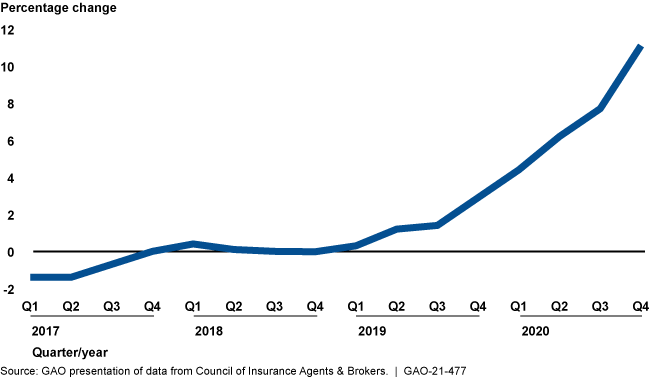- On Oct 11, 2022 5:03:49 PM
- by: Joe Rudolph
- 6 minutes Read
Since the pandemic spurred a migration to remote work, organizations have experienced a 600% increase in malicious cyber threats. New technology brings new possibilities, but it also opens the door for hackers to take advantage by exploiting vulnerabilities before you even realize you had them.
This October marks the 18th annual cybersecurity awareness month. And while it serves as a good reminder to be proactive, security is an everyday issue. Data protection should be a top priority for each organization, as modern technology increases threats daily.
With growing threats, cybersecurity premiums have risen exponentially. By 2028, the cybersecurity insurance market is expected to be valued at a staggering $26.24 billion – growth showing how more and more organizations need such insurance.

Change in Cyber Insurance Premiums, 2017-2020
How can your organization combat rising rates and growing risks? Let's bring you up to speed on the latest trends within cybersecurity, and how your organization can implement a strong IT defensive strategy.
What is Cybersecurity?
Cybersecurity includes all protective actions and technology barriers to prevent unauthorized access to internet data. As technological advancements allow for more sophisticated cyber-attacks, cybersecurity becomes increasingly important to everyone.
Cybersecurity awareness month, headed by the US Department of Homeland Security and National Cybersecurity Alliance, occurs annually in October. It was first celebrated in 2004, born of a need to create a safer internet user experience. As more and more transactions are conducted online, the vulnerability of our professional and personal information also increases.
Keeping online data protected includes a variety of tactics, including regular end user cybersecurity awareness training, strong software and hardware infrastructure, and proactive cybersecurity tactics. None of these topics is more important than the other, as each helps ensure the protective element of the other.
How COVID-19 Affected Cybersecurity
While cybersecurity has always been an essential tactic to keep data private and sensitive information under lock, the COVID-19 pandemic created an environment ripe with vulnerabilities. As the world made an emergency shift in the workplace, many organizations experienced the hardships of reactive computer security.
Several hacking tactics rely on emotional manipulation and lack of knowledge to gain access. When remote work became the norm, there was little time to prepare employees for their elevated cybersecurity risks. That’s one of the reasons why phishing scams increased by 220% during the pandemic.
Awareness of increased attacks caused by the pandemic and the 2021 executive order on cybersecurity have called for change. The 2022 cybersecurity awareness month focus revolves around behavioral impacts on internet security, including:
- Multi-Factor Authentication
- Password Strength
- Recognizing & Reporting Activity
- Software Updates
Smarter Cyber Attacks
Advancements in technology serve us all with safer experiences. However, as technology can make things easier, it can also be used to evolve malicious activity. More sophisticated tactics for phishing, malware, ransomware, and social engineering practices happen daily. Recognition is a critical component of prevention.
Information Seeking Attacks
Phishing is a tactic that relies primarily on emotion. Phishing generally preys on fear as a deceptive means of gaining confidential information. Phishing can be presented through emails, text, websites, and phone calls; all it takes to compromise your company is one click.
Forms of information farming include:
- Spear Phishing
- Whaling
- Clone Phishing
- Vishing
- Smishing
The pandemic made most people susceptible to fear, which primed an environment for increased phishing tactics. Advanced phishing tactics can almost replicate a reputable organization requesting such information.
For example, one common phishing tactic is an email looks identical to one from the health department asking you to contact them due to an exposure concern. Be wary of any outside source asking for identifying information, regardless of the level of security. A username paired with a weak password creates a wide opening for a cyber-attack.
Data Stealing Attacks
Malware includes malicious software that collects user information to disrupt or distribute that data. Malware is obtained through viral infection, trojan horse, and ransomware disguised as helpful services. Malware is sometimes recognized:
- When an unknown source asks an employee to verify the information.
- When it prompts someone to click an unknown attachment or follow a link.
- By calling for prompt action based on a targeted fear.
Remote workers could leave an organization particularly vulnerable to a malware attack. Workers operating on unsecured networks or using their personal equipment may bring malware into an organization’s network.
This type of attack is evolving, making it harder to detect and trace.
Tip: Make sure youre employees are always logging in via a virtual private network (VPN) or other secure method when they access your systems.
How Organizations are Responding
Advanced cybersecurity attacks threaten personal data and could potentially destroy an organization's reputation while causing financial havoc. Even if your cybersecurity insurance covers a breach, your rates could skyrocket.
It might be surprising to learn that most data breaches start with human error – that means your employees are your biggestcybersecurity weakness.
2022 isn’t all doom and gloom for security. Technology has been used for malicious purposes, but it’s also created more robust proactive security practices. Fortunately, there are several ways for an organization to get better protected from smarter threats:
- Proactive Firewall: A deep packet inspection prevents disguised layered attacks from getting through.
- Vulnerability Testing: Proactively seek weak areas of cybersecurity before hackers have a chance to exploit them.
- Awareness Training and Testing: Your best defense is a strong offense when employees are properly trained and tested against threats.
- Managed Detection and Response Systems: Organizations with managed discovery and response systems get proactive alerts and responses.
How to Protect Your Organization During Cybersecurity Awareness Month
It’s October, which means it’s already a great month to invest in amped-up security. Being proactive in protecting data includes education, implementation, and coordination. Start from the bottom and wrap-around services with:
- Cybersecurity Best Practices: Not everyone within your company is tech-savvy. Provide policy on basic internet terminology, increased domain risks, and practices that make them vulnerable. For example, ensuring employees log in via VPN rather than going straight into your systems with their own unsecured internet connection.
- Employee Awareness Training: Password security is a topic that is often taken too lightly. Suppose your employees use common passwords such as “12345” or “password” even on one of their personal accounts. In that case, professional information could be compromised too.
- Multi-Factor Authentication: Weak passwords are easy to crack, but requiring more than one authenticating a piece of information reduces that risk significantly. Plus, most cybersecurity insurance companies require at least some form of 2FA or MFA.
- Partner with an IT MSP: Security in 2022 requires a dynamic approach. Any vulnerability can be exploited into a major data breach. Consider working with an experienced IT MSP who will make it their duty to protect yours.
What Will You Do for Cybersecurity Awareness Month in 2022?
New ways of working from remote locations and modern technology allows for innovative ways to collaborate. Unfortunately, it also opened the door to advanced cyber-attacks.
Now is a great time to review your approach and plan, but cybersecurity is important every day of every month. Don’t wait to implement multi-factor authentication and proactive firewalls, or to educate your team on new phishing attacks.
While October is a time to highlight cybersecurity awareness month, hackers don’t wait to do malicious activity.
Consider partnering with Ceeva, your trustedMSP cybersecurity partner. For us, every month is cybersecurity awareness month – because your online safety is our top priority.
Subscribe blog for latest updates
By submitting this you will be receiving our latest updates on post.
